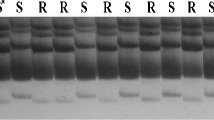Abstract
Fusarium wilt (FW) disease is an economically important disease of cotton worldwide and a major cause of crop losses in Australia and many other cotton-producing countries. Symptoms include wilting, vascular browning and death. Australian races of the causal agent Fusarium oxysporum f. sp. vasinfectum (Fov) are genetically distinct from those in other countries and are thought to have evolved from indigenous races. New sources of resistance for breeding are rare, as cotton cultivars with significant FW resistance against Fov isolates from other cotton-producing regions are usually susceptible to Australian Fov races. MCU-5, an Upland Indian cotton cultivar, has been identified as having improved resistance to Australian Fov and is being used to breed new commercial cultivars with higher resistance to FW. To investigate the genetic basis of the FW resistance in MCU-5, QTL analysis was performed on 244 F3 and 244 F4 families derived from an intraspecific cross between MCU-5 and Siokra 1-4, a cultivar highly sensitive to Australian Fov races. Resistance, as measured by leaf symptoms, vascular browning and survival, showed low to moderate heritability between generations. MCU-5 resistance to FW was found to be complex with three quantitative trait loci (QTL) identified in the F3, and eight in the F4, that explained between 9 and 41% of the phenotypic variation. The QTL were located on four linkage groups including chromosomes A6 (Chr 6), D4 (Chr 22) and D6 (Chr 25), with two QTL located in similar regions to previously identified FW resistance from the Sea Island cultivar Pima 3-79. The QTL identified in this study represent the first targets for marker-assisted selection of FW resistance in Australia.


Similar content being viewed by others
References
Allen SJ (2007) Integrated disease management for Fusarium wilt of cotton in Australia. Paper presented at the World Cotton Research Conference-4, Lubbock Memorial Civic Center, Lubbock, Texas, September 2007
Baayen RP, Sparnaaij LD, Jansen J, Niemann GJ (1991) Inheritance of resistance in carnation against Fusarium oxysporum f.sp. dianthi races 1 and 2, in relation to resistance components. Neth J Plant Pathol 97(2):73–86
Beckman CH, Roberts EM (1995) On the nature and genetic basis for resistance and tolerance to fungal wilt diseases of plants. Adv Bot Res 21:35–77
Chakrabarti A, Rep M, Wang B, Ashton A, Dodds P, Ellis J (2011) Variation in potential effector genes distinguishing Australian and non-Australian isolates of the cotton wilt pathogen Fusarium oxysporum f.sp. vasinfectum. Plant Pathol 60(2):232–243
Churchill GA, Doerge RW (1994) Empirical threshold values for quantitative trait mapping. Genetics 138(3):963–971
Cirulli M, Ciccarese F (1982) Factors affecting early screening of tomatoes for monogenic and polygenic resistance to Fusarium wilt. Crop Prot 1(3):341–348
Constable GA, Reid PE, Stiller WN (2007) Breeding for resistance to a new strain of fusarium wilt in Australia. Paper presented at the World Cotton Research Conference-4, Lubbock Memorial Civic Center, Lubbock, Texas, 10–14 September 2007
Davis RD, Moore NY, Kochman JK (1996) Characterisation of a population of Fusarium oxysporum f sp vasinfectum causing wilt of cotton in Australia. Aust J Agr Res 47(7):1143–1156
Dowd C, Wilson IW, McFadden H (2004) Gene expression profile changes in cotton root and hypocotyl tissues in response to infection with Fusarium oxysporum f sp. vasinfectum. Mol Plant Microbe In 17(6):654–667
Elmer WH (2002) Influence of inoculum density of Fusarium oxysporum f. sp cyclaminis and sodium chloride on cyclamen and the development of fusarium wilt. Plant Dis 86(4):389–393
Famhy T (1927) The Fusarium wilt disease of cotton and its control. Phytopathology 17:749–767
Feng C, Zhang J, Liu J, Guo J, Sun J (1996) Inheritance of resistance of fusarium wilt in several chinese upland cotton varieties. Acta Agron Sin 22:550–554
Gao HR, Beckman CH, Mueller WC (1995) The nature of tolerance to Fusarium oxysporum F-sp lycopersici in polygenically field-resistant marglobe tomato plants. Physiol Mol Plant P 46(5):401–412
Guo WZ, Cai CP, Wang CB, Han ZG, Song XL, Wang K, Niu XW, Wang C, Lu KY, Shi B, Zhang TZ (2007) A microsatellite-based, gene-rich linkage map reveals genome structure, function and evolution in Gossypium. Genetics 176(1):527–541
Hillock RJ (1992) Fusarium wilt. In: Hillocks RJ (ed) Cotton diseases. CAB International, Wallingford, pp 127–160
Joobeur T, King JJ, Nolin SJ, Thomas CE, Dean RA (2004) The fusarium wilt resistance locus Fom-2 of melon contains a single resistance gene with complex features. Plant J 39(3):283–297
Kanniyan K, Marappan PV (1969) Madras Cambodia Uganda-5, an extra long staple strain of cotton. Madras Agr J 5:231–234
Kanniyan K, Marappan PV (1970) MCU5 A new superior long staple cotton. Indian Farm 20(2):11–13
Kappelman AJ (1971) Inheritance of resistance to Fusarium wilt in cotton. Crop Sci 11(5):672–674
Kim Y, Hutmacher RB, Davis RM (2005) Characterization of California isolates of Fusarium oxysporum f. sp. vasinfectum. Plant Dis 89(4):366–372
Kochman JK (1995) Fusarium-wilt in cotton—a new record in Australia. Australas Plant Pathol 24(1):74
Kochman JK, Moor N, Obst NR, O’Neill W, Salmond G, Bentley S (2000) Management strategies for Fusarium wilt of cotton. In: The 10th Australian cotton conference Brisbane. Australian Cotton Growers Association
Lacape JM, Jacobs J, Arioli T, Derijcker R, Forestier-Chiron N, Llewellyn D, Jean J, Thomas E, Viot C (2009) A new interspecific, Gossypium hirsutum x G. barbadense, RIL population: towards a unified consensus linkage map of tetraploid cotton. Theor Appl Genet 119(2):281–292
Lopez-Lavalle LAB, McFadden H, Brubaker CL (2007) The effect of Gossypium C-genome chromosomes on resistance to fusarium wilt in allotetraploid cotton. Theor Appl Genet 115(4):477–488
McFadden H, Beasley D, Brubaker CL (2004) Assessment of Gossypium sturtianum and G. australe as potential sources of fusarium wilt resistance to cotton. Euphytica 138(1):61–72
McPherson MG, Jenkins JN, Watson CE, Jr MJC (2004) Inheritance of root-knot nematode resistance in M-315 RNR and M78-RNR cotton. J Cotton Sci 8:154–161
Mohamed HA (1963) Inheritance of resistance to fusarium wilt in some Egyptian cottons. Emp Cotton Grow Rev 40:292
Nash SM, Snyder WC (1962) Quantitative estimations by plate counts of propagules of bean root rot Fusarium in field soils. Phytopathology 52(6):567–572
Nyquist WE (1991) Estimation of heritability and prediction of selection response in plant-populations. Crit Rev Plant Sci 10(3):235–322
Perchepied L, Pitrat M (2004) Polygenic inheritance of partial resistance to Fusarium oxysporum f. sp. melonis race 1.2 in melon. Phytopathology 94(12):1331–1336
Rampling LR, Harker N, Shariflou MR, Morell MK (2001) Detection and analysis systems for microsatellite markers in wheat. Aust J Agr Res 52(11–12):1131–1141
Rao MV, Rao AS (1966) Fusarium wilt of cotton in relation to inoculum potential. Br Mycol Soc Trans 49:403–409
Schuelke M (2000) An economic method for the fluorescent labeling of PCR fragments. Nat Biotechnol 18(2):233–234
Sela-Buurlage MB, Budai-Hadrian O, Pan Q, Carmel-Goren L, Vunsch R, Zamir D, Fluhr R (2001) Genome-wide dissection of fusarium resistance in tomato reveals multiple complex loci. Mol Genet Genomics 265(6):1104–1111
Smirnov N (1948) Table for estimating the goodness of fit of empirical distributions. Ann Math Stat 19(2):279
Smith AL, Dick JB (1960) Inheritance of resistance to fusarium wilt in upland and sea island cottons as complicated by nematodes under field conditions. Phytopathology 50(1):44–48
Stam P (1993) Construction of integrated genetic-linkage maps by means of a new computer package—Joinmap. Plant J 3(5):739–744
Stiller, WN, Constable, GA, Reid, P. (2009) Resistance to the new Australian strain of fusarium wilt among non-cultivated Gossypium. SABRAO J Breed Genet 41 Special Supplement. http://www.sabrao.org/apbc14/papers/apb09Final00224.pdf
Ulloa M, Hutmacher R, Davis R, Wright S, Percy R, Marsh B (2006) Breeding for fusarium wilt race 4 resistance in cotton under field and greenhouse conditions. J Cotton Sci 10:114–127
Ulloa M, Wang C, Hutmacher R, Wright S, Davis R, Saski C, Roberts P (2011) Mapping fusarium wilt race 1 resistance genes in cotton by inheritance, QTL and sequencing composition. Mol Genet Genomics 286:21–36
Van Deynze A, Stoffel K, Lee M, Wilkins TA, Kozik A, Cantrell RG, Yu JZ, Kohel RJ, Stelly DM (2009) Sampling nucleotide diversity in cotton. BMC Plant Biol 9:125
Van Ooijen JW (2004) MapQTL® 5, Software for mapping of quantitative triat loci in experimental populations, 5th edn. Kyazma B.V, Wageningen
Vos P, Hogers R, Bleeker M, Reijans M, Vandelee T, Hornes M, Frijters A, Pot J, Peleman J, Kuiper M, Zabeau M (1995) AFLP—a new technique for DNA-fingerprinting. Nucleic Acids Res 23(21):4407–4414
Wang B, Dale ML, Kochman JK (1999) Studies on a pathogenicity assay for screening cotton germplasms for resistance to Fusarium oxysporum f. sp. vasinfectum in the glasshouse. Aust J Exp Agr 39(8):967–974
Wang B, Brubaker CL, Burdon JJ (2004) Fusarium species and fusarium wilt pathogens associated with native Gossypium populations in Australia. Mycol Res 108:35–44
Wang PZ, Su L, Qin L, Hu BM, Guo WZ, Zhang TZ (2009) Identification and molecular mapping of a fusarium wilt resistant gene in upland cotton. Theor Appl Genet 119(4):733–739
Wang P-Z, Shi L-F, Su L, Hu B-M (2010) Quantative trait loci for resistance against fusarium wilt based on three cotton F2 populations. Agri Sci China 9(12):1799–1806
Xiao J, Wu K, Fang DD, Stelly DM, Yu J, Cantrell RG (2009) New SSR markers for use in cotton (Gossypium spp.) improvement. J Cotton Sci 13:75–157
Acknowledgments
We would like to acknowledge the technical assistance of Merran Hunter, mapping guidance by Karen Aitken and statistical advice provided by Shiming Liu. We also thank Wolfgang Spielmeyer and Shannon Dillon for critical reading of the manuscript. This work was supported by Cotton Breeding Australia, a joint venture between Cotton Seed Distributors and CSIRO.
Author information
Authors and Affiliations
Corresponding author
Electronic supplementary material
Below is the link to the electronic supplementary material.
Rights and permissions
About this article
Cite this article
Lopez-Lavalle, L.A.B., Gillespie, V.J., Tate, W.A. et al. Molecular mapping of a new source of Fusarium wilt resistance in tetraploid cotton (Gossypium hirsutum L.). Mol Breeding 30, 1181–1191 (2012). https://doi.org/10.1007/s11032-012-9705-z
Received:
Accepted:
Published:
Issue Date:
DOI: https://doi.org/10.1007/s11032-012-9705-z




